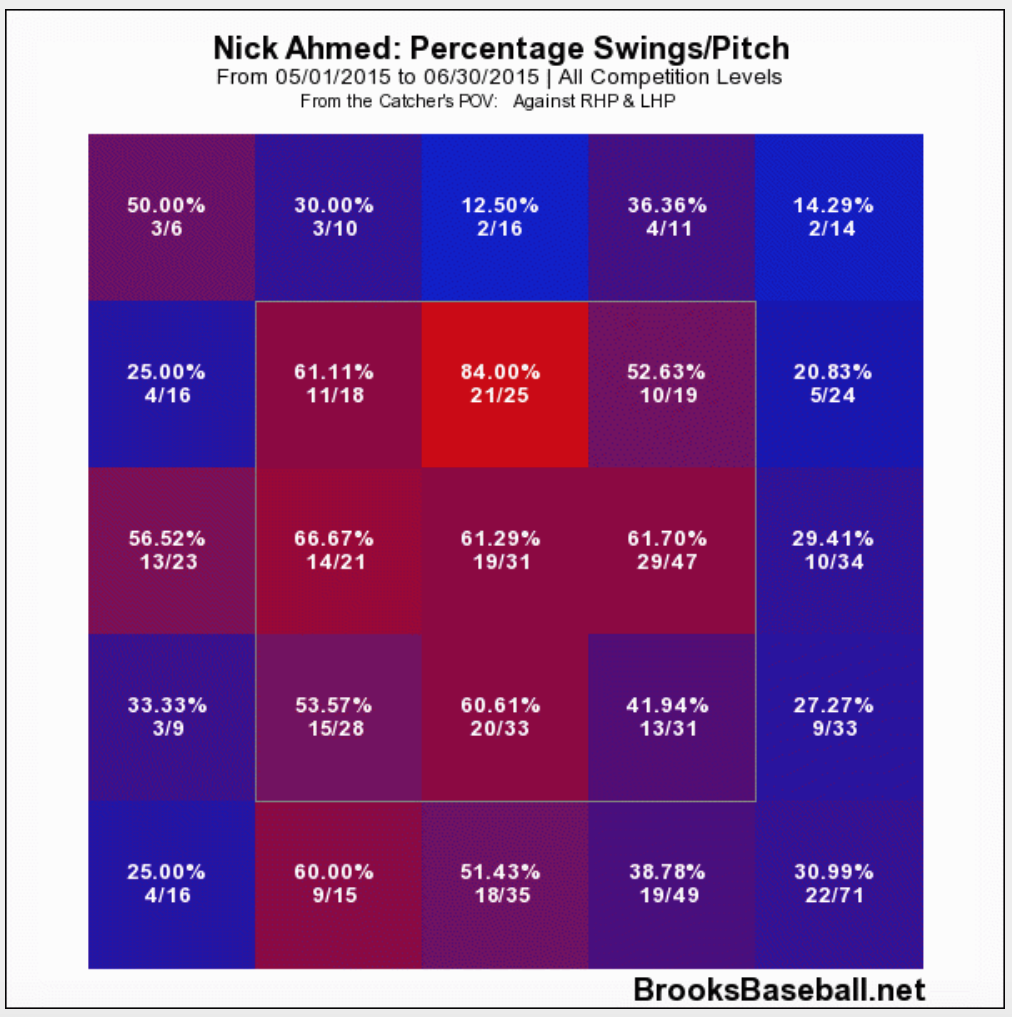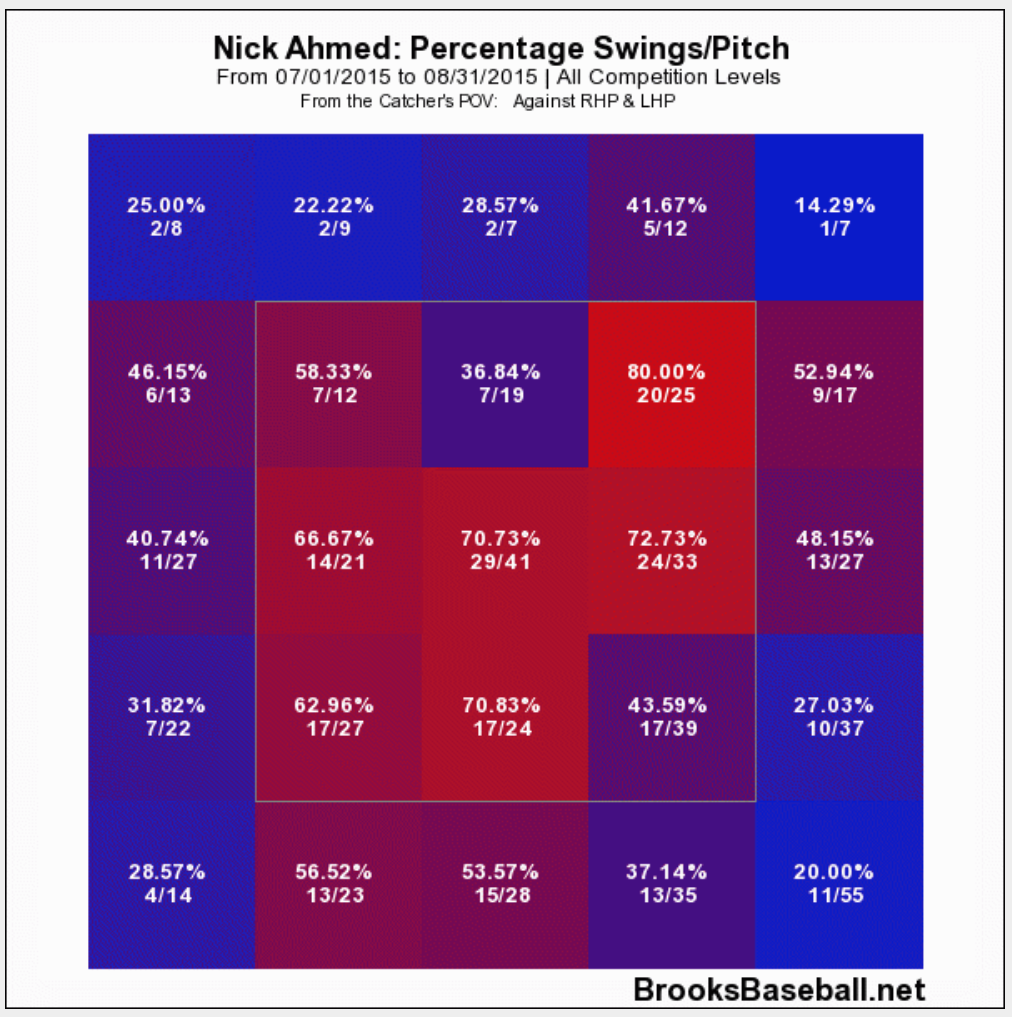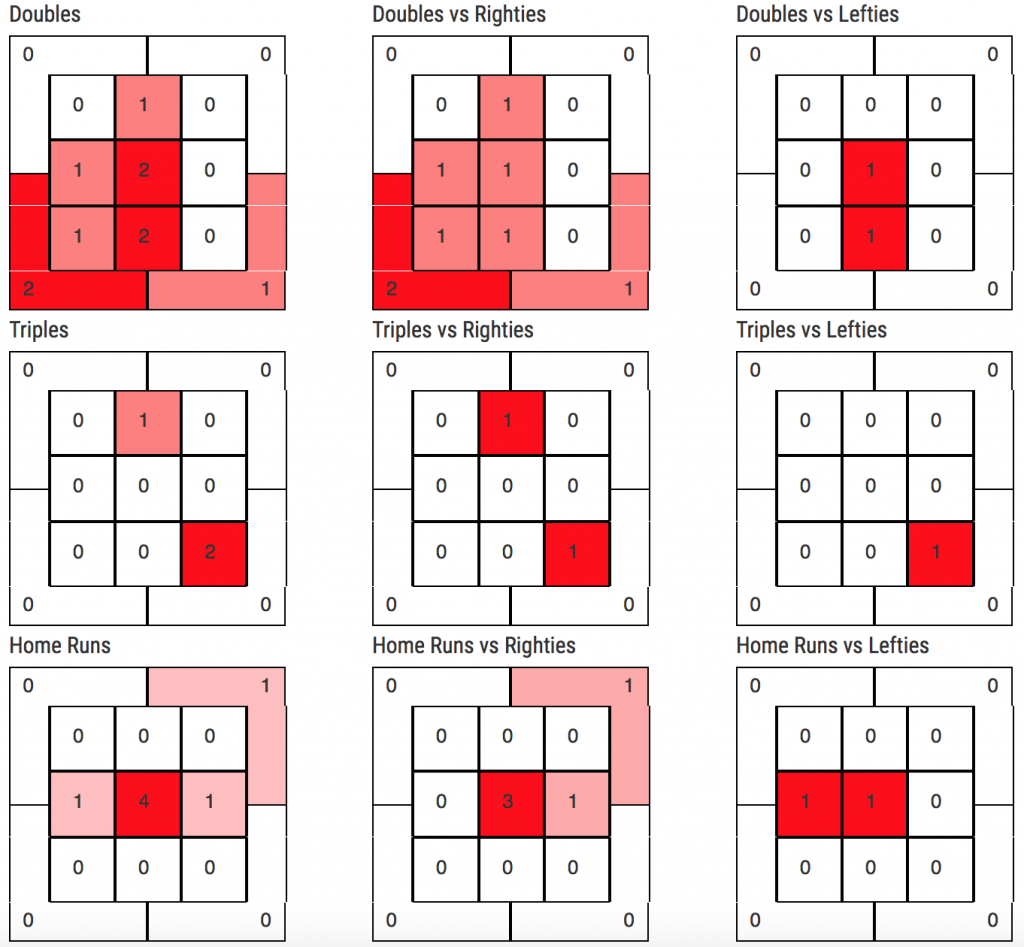Diminished Plate Discipline is Undoing Nick Ahmed
Ups and downs are part of the game of baseball. Whether you want to admit it or not, it’s this series of changes that helps make baseball so compelling. Without the ebbs and flows, the waxing and the waning, the ever-changing currents, the game would be far too static. This a lot easier to admit when you’re working with that current and riding the wave like David Peralta is right now. It’s a lot harder when you’re swimming upstream and struggling to do so like Nick Ahmed. While Peralta’s breakthrough’s being hailed throughout the baseball media, it’s Ahmed’s trials and tribulations that’ve gone mostly unnoticed.
The theme here is expectations. Ahmed’s were to play a good defensive shortstop and not provide much offensively. It seemed like being a Role 6 defender who hit .230 was to be expected. After the first month of the season, it was clear that Ahmed was more like Role 7 defender, nearing the peak of the defensive spectrum at short. At the plate, he couldn’t reach the Mendoza Line and it wasn’t clear if Nick Ahmed could stick in the majors, even with a truly elite glove. Then May and June happened and Ahmed took a massive leap forward at the plate without losing anything in the field. Unfortunately, the success was fleeting as he followed up two excellent months with two really, really poor ones.
Nick Ahmed has met or exceeded expectations in the field, but he’s never met them at the plate – he’s either underwhelmed or far-exceeded what was projected offensively. The hot and cold nature of his production leaves many questions, namely: can Nick Ahmed get back to being productive at the dish? If the answer is “no,” then it would appear that Ahmed will have a short-lived career as a second divisions starter and ultimately a utility guy. If the answer is “yes,” then he might just be an All Star someday. The gap here is pretty wide and hinges on his performance in the batter’s box.
So what drug him down in the first place? As it turns out, there are some pretty obvious answers when we look at the data. As a general methodology, let’s compare two chunks of time, Ahmed’s “hot” May and June and his “cold” July and August. We’ll throw out March because he was still getting his feet wet and learning to play every day at the major league level.
His plate discipline, judged by his propensity to swing, during his “hot” months, was pretty good. See below:
Not a lot of chasing, lots of swings in the zone. The plate discipline looks pretty sound. This resulted in 41 hits in 48 games. Now take a look at his plate discipline, measured the exact same way, over the following two “cold” months, resulting in 30 hits in 47 games.
He still likes the pitch inside, but over his cold period, he started expanding the zone outside. He also swung more down in the zone. He did lay of some of the high pitches that had been plaguing him in the past, but the rest of the zone expansion didn’t do him any favors. Those swings aren’t productive. Ahmed has done the vast, vast majority of his damage in the zone as one would expect.
Those swings out of the zone aren’t producing positive results, they’re just putting him behind in the count. It’s tough for a young hitter, particularly one who doesn’t hit the ball consistently hard, to get behind. During his hot months, he was behind in the count for 106 of the 398 pitches (26.6%) he was thrown. During his cold months, he was behind with 180 of the 415 pitches (43.4%) he saw. That’s a massive shift that’s clearly effecting his outcomes. Instead of sitting in the driver’s seat, he’s getting behind early and putting himself in poor counts where he’s trying to survive and not doing so.
And this all comes back to his expectations. Offensively, they were low but we’ve seen glimpses of what Nick Ahmed is truly capable of. It would appear that for a guy like Ahmed, one who isn’t an offensive force but has the tools to hold his own, the little things are going to matter greatly. Not falling behind and keeping himself in good hitter’s counts makes a huge difference. His glove will keep him in the game, but in the National League, there’s already one hole in the batting order and good teams can’t afford two (or three, Chris Owings). The reduced plate discipline is diminishing Nick Ahmed’s ability. If he can get back to controlling the zone, he’ll give himself a chance to hit. He doesn’t have to hit a lot to earn his reps, but he can do better than this. We’ve seen it before and, hopefully, we’ll see it again very soon.
5 Responses to Diminished Plate Discipline is Undoing Nick Ahmed
Leave a Reply Cancel reply
Recent Posts
@ryanpmorrison
 Congrats to @OutfieldGrass24 on a beautiful life, wedding and wife. He deserves all of it (they both do). And I cou… https://t.co/JzJtQ7TgdJ, Jul 23
Congrats to @OutfieldGrass24 on a beautiful life, wedding and wife. He deserves all of it (they both do). And I cou… https://t.co/JzJtQ7TgdJ, Jul 23 Best part of Peralta’s 108 mph fliner over the fence, IMHO: that he got that much leverage despite scooping it out… https://t.co/ivBrl76adF, Apr 08
Best part of Peralta’s 108 mph fliner over the fence, IMHO: that he got that much leverage despite scooping it out… https://t.co/ivBrl76adF, Apr 08 RT @OutfieldGrass24: If you're bored of watching Patrick Corbin get dudes out, you can check out my latest for @TheAthleticAZ. https://t.co/k1DymgY7zO, Apr 04
RT @OutfieldGrass24: If you're bored of watching Patrick Corbin get dudes out, you can check out my latest for @TheAthleticAZ. https://t.co/k1DymgY7zO, Apr 04 Of course, they may have overtaken the league lead for outs on the bases just now, also...
But in 2017, Arizona ha… https://t.co/38MBrr2D4b, Apr 04
Of course, they may have overtaken the league lead for outs on the bases just now, also...
But in 2017, Arizona ha… https://t.co/38MBrr2D4b, Apr 04 Prior to the games today, there had only been 5 steals of 3rd this season (and no CS) in the National League. The… https://t.co/gVVL84vPQ5, Apr 04
Prior to the games today, there had only been 5 steals of 3rd this season (and no CS) in the National League. The… https://t.co/gVVL84vPQ5, Apr 04
Powered by: Web Designers@outfieldgrass24
 Starting 2022 with a frigid dog walk sounds just lovely https://t.co/xoLZSZBpGp, Jan 01
Starting 2022 with a frigid dog walk sounds just lovely https://t.co/xoLZSZBpGp, Jan 01 I’ll never forget seeing Kyle Seager at the Scottsdale Fashion Square one March with his family and thinking “damn,… https://t.co/uapNYdsU2a, Dec 30
I’ll never forget seeing Kyle Seager at the Scottsdale Fashion Square one March with his family and thinking “damn,… https://t.co/uapNYdsU2a, Dec 30 Big dogs. Bigger trees. @ Avenue of the Giants, Nor Cal https://t.co/YAdxcE1t1p, Dec 29
Big dogs. Bigger trees. @ Avenue of the Giants, Nor Cal https://t.co/YAdxcE1t1p, Dec 29 Old friend alert https://t.co/7HQjiyBWTB, Dec 27
Old friend alert https://t.co/7HQjiyBWTB, Dec 27 Death wish https://t.co/XJzcMkNPTy, Dec 26
Death wish https://t.co/XJzcMkNPTy, Dec 26
Powered by: Web Designers









I like Ahmed as a player. He seems cut from the same cloth as other great “baseball” guys like Counsell or Hammock, and I think he can make a career for himself. I just feel less sanguine about giving him a full shot when, in my opinion, it seems to be hurting the development of Chris Owings. Owings plate appearances are diminished and he isn’t developing into as valuable a player as he could be while he is sharing time at 2nd. In light of the Didi trade it seems like a less than optimal use of player resources.
That said, I would be thrilled if Ahmed is in a slump right now rather than at his average. Looking at UZR and DRS it seems he would be a top 15 SS if he could even approach 40th or so percentile wRC for shortstops. I don’t mind looking stupid, as you can surely tell.
It’s hard to say Chris Owings hasn’t had his chances, he’s going to end the year with close to 500 ABs. He’s also hit well lately, so maybe that’s a sign. Defensively, he’s better at second than he is at short and Ahmed is the best defender on the team, so the alignment is sound. It’s just a matter of these guys continuing to make adjustments. The team can’t stomach both of these performances if they want to contend. If they pick one, you pick Ahmed for the glove. Owings doesn’t walk (8th lowest BB% among players with 400 PA’s) and if he doesn’t hit, especially for a little bit of power, there’s really nothing left.
Owings certainly needs to pick up the pace and I agree if he doesn’t hit, regardless of position, he isn’t going to make it.
I guess I was getting more to the idea that his potential at the plate would be amplified if he was at shortstop even as an average defender. He is still only 24, and seems to have room for growth in both areas. The death of talent at SS in the league might have amplified his trade value. With Ahmed, Drury, and Lamb all solid young infield options behind him and glaring needs elsewhere (pitching), he might have been (maybe still could be) a solid trade piece.
I try never to hold my breath for too long, but if Swanson is a two years to the majors type draft pick (McDaniels at Fangraphs had him #27 on his prospects list I think) then really Owings may be the best in-the-majors piece we have.
“Dearth” of talent. Not a lot of great SS’s in the league but they aren’t completely corpse like out there.
Agreed. We seem to have a lot of “almost there” options between 2nd/SS/3rd which can be seen either as lottery picks – which one is gonna take the step forward? – or sign of the weakness of our system. It feels similar to our SP situation. A lot of major leaguers, but no stand out stars. My concern, which has been covered here before, is that a lot of major leaguers makes a decent team (like the one this year) but doesn’t win championships. Or at least doesn’t beat the Dodgers or Cardinals on a regular basis.